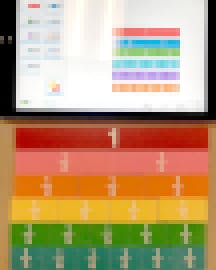“I hope it works, I hope it works,” I muttered to myself as Tonja, the student teacher in our classroom, logged into Zoom to reach the remote learners in our class.
As the program started, I couldn’t help but think how different her experience as a preservice teacher was from my own. Eighteen years ago, when I was a student-teacher, I started out by silently sitting in the back of an elementary-grade classroom, watching, observing and taking notes. I didn’t get much time to interact with students.
Eventually, I was able to take over responsibility for one class every two weeks. My supervising teacher would sit at her desk and take notes, and we would discuss how the lesson went and how I could improve. At the time, technology in the classroom was limited to two Macintosh computers that ran programs on floppy disks. They were used by students to play games and practice basic math skills. There were no iPads, no online assessments and no Zoom.
And there was no pandemic.
We reopened our schools last August and allowed families the option to continue learning remotely. They appreciated this flexibility, but it also meant that preservice teachers like Tonja would need to apply everything they learned about teaching to two very different modalities: in-person and online. Often, at the same time!

Co-teaching is not new, but the pandemic has forced many of us to iterate the model to prepare future teachers, especially as it has stretched their technological know-how and comfort level, as many now teach kids who are in class and on screens.
Over the last few months, Tonja and I have been fine-tuning many elements of the co-teaching model to more effectively support her as a student-teacher during this unprecedented time. Using a framework developed by the University of Nebraska Omaha’s College of Education, here’s how we’ve adapted seven co-teaching strategies for these trying times.
1. One Teach, One Observe
In this model, the student-teacher and cooperating teacher decide who is going to teach and who is going to observe. This model can be used when data needs to be collected for a specific reason, or when specific feedback on an aspect of instruction is sought.
What we’ve done: Tonja and I use this model to track student behavior and adjust our teaching accordingly. Since she is learning how to manage the flow of a classroom, I watch how students react to and engage with her lessons. If someone is not focusing on the material or seems to be frustrated, we use that to shape our professional development conversations, and consider alternative teaching strategies and when to implement them.
Having online learners added new challenges. As Tonja taught a lesson, I would watch the iPad and monitor how our remote students were doing. Some of the online “behaviors” that I look for: Were they paying attention? Were they using the chat correctly? If they did have questions, was Tonja able to move between in person and remote questions?
2. One Teach, One Assist
In this model, the student-teacher and cooperating teacher decide who will lead instruction while the other teacher assists managing the class. This model is especially handy in situations where certain behaviors necessitate a quick response.
What we’ve done: While this co-teaching strategy was designed for monitoring student behavior, Tonja and I found it extremely useful to have one person on hand to provide tech support for our remote learners. If there was an issue with technology, Tonja could continue teaching the in-person students while I worked to resolve whatever issue was occurring with their online peers.
3. Station Teaching
In this model, the student-teacher and cooperating teacher set up instructional stations that they guide students through. Students who are not at a station could be doing independent work, or reviewing skills in a small group.
What we’ve done: After our brief mini-lesson on fractions, we assigned students to different stations based on a unit pretest that Tonja had given, along with informal observations we made during instruction. (For remote learners, we used an online assessment.)
Both Tonja and I worked with separate groups of students. Her group focused on changing improper fractions to mixed numbers and my group worked on adding and subtracting mixed numbers. To make this work for remote students, we had them join our class via Zoom. Throughout the class, the in-class students would carry the devices where our remote students appeared from station to station—as if they were actually in class.
We were careful to design stations to be compatible with remote learning. One station involved working on a math journal page that the remote students had access to. Another station involved working on review skills on a math app they also could access. At a third station, students played fraction bingo. The in-person students place the bingo chips on the card of their remote learner peers, who then participate as if they were there.
4. Parallel Teaching
In this model, the class is split in half, and the student-teacher and cooperating teacher simultaneously teach the same material to their groups.
What we’ve done: Our students have been creating books for their penpals in India, and Tonja and I use this model to organize our conversations with students about their progress.
After a mini-lesson on preselected writing concepts, students were given time to research and complete their project. Tonja and I separated the class alphabetically by last name, and we had both in-class and remote learners in our groups. We used Zoom so that if a remote learner had a question, they could easily reach one of us. We asked that they email their writing to us, and we would conference with them.
5. Supplemental Teaching
In this model, the student-teacher and cooperating teacher decide what will be taught to a smaller group of students lead by one of the teachers, while the other leads the larger group of students in a separate activity. Sometimes the students in the smaller group will be those who need additional support; or they may be advancing at a quicker pace than the rest of the class. As such, this model can be used to meet the individual needs of students.
What we’ve done: We have used this model to reteach concepts to certain students and to introduce more advanced ones for those who are ready. Sometimes, Tonja will work on reteaching a specific concept to the remote students while I work with the in-person group on the next sequence in the curriculum.
6. Alternative Teaching
In this model, the student-teacher and cooperating teacher use two different instructional approaches to cover the same concept. This model is useful when students do not initially understand a concept, or when remote learners do not have access to the same educational materials as their in-person peers.

What we’ve done: We have found that this model can be extremely useful for simultaneous in-person and remote environments. In our less on fractions, Tonja works with the in-person learners using hands-on fraction strips, while I guide our remote students using other apps or programs.
This model can have mixed results. Some of the apps and programs that we tried did not work out. The remote learners once were frustrated because an app we tried to simulate the physical fraction strips did not turn out to be effective. If you plan on using this model with remote learners, you should fully investigate and practice with each app or program you plan on using. At the end of the day, whatever you use, you want your remote students to understand the lesson concepts just as much as their in-person classmates.
7. Team Teaching
In this model, both teachers act as experts and are free to interject at any point in the learning process. This allows each teacher to present and share information, in a manner that resembles a natural dialogue, so that students hear multiple perspectives.
What we’ve done: Tonja and I have developed a strong professional relationship. We often interject with different ideas, or answer students’ questions without missing a beat. Using this model has allowed us to bring our best selves to the classroom. There are often times that our lessons become richer due to the professional interactions that team teaching affords.
Towards the end of Tonja’s lesson on adding fractions with like denominators, I observed that most students had done a fantastic job of grasping the concept. Using this strategy, I asked students to complete a few additional problems on their mini white-boards, or on a piece of paper if they were remote learners. As the students completed the work, both Tonja and I circulated through the room and monitored the online learners to focus on the students who needed additional support.
One reason this partnership has been successful is that our district has developed a handbook that clearly defines the roles of both the cooperating teacher and the student teacher. Having the different responsibilities and expectations clearly spelled out helps do away with many misunderstandings that may occur in the co-teaching process.

It has been almost a year since the world seemed to stop in its tracks, thrusting the education community into the unknown, and we must take a serious look at how our teacher training models support those who are entering our workforce during these unprecedented times. For us, co-teaching has been effective at supporting not just future teachers like Tonja, but our future adults as well.


